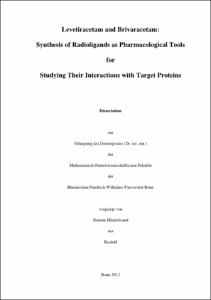Hildenbrand, Simone: Levetiracetam and Brivaracetam : Synthesis of Radioligands as Pharmacological Tools for Studying Their Interactions with Target Proteins. - Bonn, 2012. - Dissertation, Rheinische Friedrich-Wilhelms-Universität Bonn.
Online-Ausgabe in bonndoc: https://nbn-resolving.org/urn:nbn:de:hbz:5n-30687
Online-Ausgabe in bonndoc: https://nbn-resolving.org/urn:nbn:de:hbz:5n-30687
@phdthesis{handle:20.500.11811/5419,
urn: https://nbn-resolving.org/urn:nbn:de:hbz:5n-30687,
author = {{Simone Hildenbrand}},
title = {Levetiracetam and Brivaracetam : Synthesis of Radioligands as Pharmacological Tools for Studying Their Interactions with Target Proteins},
school = {Rheinische Friedrich-Wilhelms-Universität Bonn},
year = 2012,
month = dec,
note = {Epilepsy is one of the most common neurological disorders affecting more than 50 million people worldwide. Despite extensive efforts in antiepileptic drug (AED) development it is estimated that around 30% of all epileptic patients remain resistant to current AED therapy. In addition, the majority of conventional AEDs exhibits a large spectrum of side effects and a high potential of drug interactions (cytochrome P450), which restrict their applicability. In 1999, the antiepileptic drug levetiracetam (LEV, (2S)-2-(2-oxopyrrolidin-1-yl)butanamide, Keppra®) was launched on the market and soon became one of the most successful AEDs of the newer generation. It binds to the synaptic vesicle protein SV2A and thus appears to exert its potent antiepileptic effect via a unique mechanism of action that is, however, still not well understood. Its analogue brivaracetam (BRV), which possesses a 10- to 20-fold higher affinity to the SV2A protein, is currently in late stages of phase III clinical trials.
In the present study, synthetic pathways were devised for precursor molecules of LEV and BRV suitable for generating 3H-labeled forms of both AEDs with high specific activity (94-98 Ci/mmol). In a reductive amination reaction mucochloric acid and previously prepared (S)-2-aminobutanamide were applied in the presence of sodium triacetoxyborohydride and acetic acid to synthesize (S)-2-(3,4-dichloro-2,5-dihydro-2-oxo-1H-pyrrol-1-yl)butanamide, which served as precursor for the preparation of [3H]LEV. The second precursor molecule was prepared via the intermediate 4-allyl-5-hydroxyfuran-2(5H)-one, obtained in a Mannich type reaction of glyoxylic acid and pent-4-enal in the presence of morpholine hydrochloride, which was subsequently utilized in a reductive amination reaction with (S)-2-aminobutanamide for the preparation of (S)-2-(4-allyl-2-oxo-2,5-dihydro-1H-pyrrol-1-yl)butanamide. This precursor molecule allowed the generation of [3H]BRV and its diastereomer [3H]isoBRV. In subsequent binding studies the applicability of the new radioligands was confirmed. [3H]BRV, exhibiting the highest target affinity, proved to be highly useful for the screening of ligands that compete with its binding, as well as for examinations of rare clinical brain samples of epileptic patients. Binding studies with [3H]BRV at recombinantly expressed SV2A protein variants revealed that the long cytoplasmic loop of the SV2A protein could potentially be involved in ligand-binding interactions. A previously postulated direct interaction of LEV with AMPA receptors could not be confirmed in our binding studies so far. Initial experiments at brain membrane preparations of SV2A KO mice were performed to investigate [3H]BRV binding in the absence of SV2A with the intention to identify potential low-abundant target sites. Due to its high specific activity the new radioligand [3H]BRV represents a most valuable tool for the extension of these studies with the goal to identify potential novel, low-abundant targets.},
url = {https://hdl.handle.net/20.500.11811/5419}
}
urn: https://nbn-resolving.org/urn:nbn:de:hbz:5n-30687,
author = {{Simone Hildenbrand}},
title = {Levetiracetam and Brivaracetam : Synthesis of Radioligands as Pharmacological Tools for Studying Their Interactions with Target Proteins},
school = {Rheinische Friedrich-Wilhelms-Universität Bonn},
year = 2012,
month = dec,
note = {Epilepsy is one of the most common neurological disorders affecting more than 50 million people worldwide. Despite extensive efforts in antiepileptic drug (AED) development it is estimated that around 30% of all epileptic patients remain resistant to current AED therapy. In addition, the majority of conventional AEDs exhibits a large spectrum of side effects and a high potential of drug interactions (cytochrome P450), which restrict their applicability. In 1999, the antiepileptic drug levetiracetam (LEV, (2S)-2-(2-oxopyrrolidin-1-yl)butanamide, Keppra®) was launched on the market and soon became one of the most successful AEDs of the newer generation. It binds to the synaptic vesicle protein SV2A and thus appears to exert its potent antiepileptic effect via a unique mechanism of action that is, however, still not well understood. Its analogue brivaracetam (BRV), which possesses a 10- to 20-fold higher affinity to the SV2A protein, is currently in late stages of phase III clinical trials.
In the present study, synthetic pathways were devised for precursor molecules of LEV and BRV suitable for generating 3H-labeled forms of both AEDs with high specific activity (94-98 Ci/mmol). In a reductive amination reaction mucochloric acid and previously prepared (S)-2-aminobutanamide were applied in the presence of sodium triacetoxyborohydride and acetic acid to synthesize (S)-2-(3,4-dichloro-2,5-dihydro-2-oxo-1H-pyrrol-1-yl)butanamide, which served as precursor for the preparation of [3H]LEV. The second precursor molecule was prepared via the intermediate 4-allyl-5-hydroxyfuran-2(5H)-one, obtained in a Mannich type reaction of glyoxylic acid and pent-4-enal in the presence of morpholine hydrochloride, which was subsequently utilized in a reductive amination reaction with (S)-2-aminobutanamide for the preparation of (S)-2-(4-allyl-2-oxo-2,5-dihydro-1H-pyrrol-1-yl)butanamide. This precursor molecule allowed the generation of [3H]BRV and its diastereomer [3H]isoBRV. In subsequent binding studies the applicability of the new radioligands was confirmed. [3H]BRV, exhibiting the highest target affinity, proved to be highly useful for the screening of ligands that compete with its binding, as well as for examinations of rare clinical brain samples of epileptic patients. Binding studies with [3H]BRV at recombinantly expressed SV2A protein variants revealed that the long cytoplasmic loop of the SV2A protein could potentially be involved in ligand-binding interactions. A previously postulated direct interaction of LEV with AMPA receptors could not be confirmed in our binding studies so far. Initial experiments at brain membrane preparations of SV2A KO mice were performed to investigate [3H]BRV binding in the absence of SV2A with the intention to identify potential low-abundant target sites. Due to its high specific activity the new radioligand [3H]BRV represents a most valuable tool for the extension of these studies with the goal to identify potential novel, low-abundant targets.},
url = {https://hdl.handle.net/20.500.11811/5419}
}






